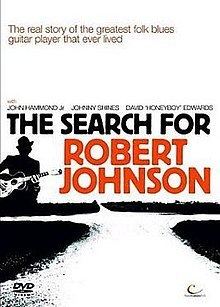9 /10 1 Votes9
Directed by Chris Hunt Edited by Stuart Davidson Director Chris Hunt | 4.5/5 Amazon Produced by Chris Hunt Cinematography Paul Bond, Ken Morse Initial release 1991 Music director Robert Johnson Narrated by John P. Hammond | |||||||||||||||||||||||||||||||||
 | ||||||||||||||||||||||||||||||||||
Starring Johnny ShinesDavid Honeyboy Edwards Cast Robert Johnson, Eric Clapton, John P Hammond, David "Honeyboy" Edwards, Keith Richards Similar The Soul of a Man, The Howlin' Wolf Stor, The Life & Music of Robert Jo, Deep Blues: A Musical P, Eric Clapton: Sessions | ||||||||||||||||||||||||||||||||||
The Search for Robert Johnson is a 1991 UK television documentary film about the Delta blues musician Robert Johnson, hosted by John Hammond, and produced and directed by Chris Hunt. In it, Hammond travels through the American Deep South to pursue topics such as Johnson's birth date, place and parents, his early musical development, performances and travels, romances, his mythic "pact with the devil," his untimely murder in his late twenties, the discovery of possible offspring, and the uncertainty over where Johnson is buried. Throughout, Johnson's music is both foreground and background, from recordings of Johnson and as performed on camera by Hammond, David Honeyboy Edwards, and Johnny Shines.
Contents
Documentary
Blues musician and "keeper of the flame" John Hammond described his journey into the American South as "the quest of a lifetime". His father, record producer and jazz impresario John H. Hammond, had planned and advertised for Robert Johnson to perform at Carnegie Hall, but Johnson died prior to the concert.
The film is loosely organised around field work by Johnson researcher Robert "Mack" McCormick. Throughout the film, Hammond travels to locations where Johnson lived, performed, recorded, and purportedly where he died, and interviews two of Johnson's girlfriends and blues musicians who knew him, as well as two noted blues researchers. Locations include the "Delta, the floodplain of northwestern Mississippi, on into Arkansas and Texas, and into southern Mississippi, where he was born and died."
The film has been noted for its presentation of new evidence, at the time, about Johnson's life.
Interviewees
Guitarists Keith Richards and Eric Clapton, blues researchers Gayle Dean Wardlow and Robert "Mack" McCormick, childhood acquaintance Wink Clark, Nat Richardson, a "juke house" owner's son, Delta blues musicians David Honeyboy Edwards and Johnny Shines, girlfriends Willie Mae Powell and 'Queen' Elizabeth, discovered son Claude Johnson, his son Gregory and grandson Richard, Greenwood Councillor David Jordan, and cemetery attendant Miller Carter were all interviewed for the film.
Reception
The film received positive reviews, especially from musicians and music critics. Upon its broadcast in 1992, UK producer and blues critic Neil Slaven, quoted later by Schroeder, wrote that the film "encompasses a detective story overlaid with folk memory, its interviews succinctly to the point, containing humor, superstition, and contextural information in equal parts." Folk singer Dave Van Ronk, reviewing the released video for Entertainment Weekly, wrote of its "lucid narration," and gave the film an "A," satisfied that it stayed focused on the music. Chicago Tribune reviewer Bill Dahl's four-star review termed the film "fascinating" and summarised, "Questions remain about this blues legend who claimed he sold his soul to achieve musical immortality, but this exceptional video answers a great many of them." Prior to its showing on American network Bravo, a 1994 New York Times review described the film as "outstanding" and "a riveting combination of biography and American history."
Upon the Sony DVD's release in 2000, Ian Morris of MichaelDVD.com rated the film itself at 4.5/5 stars, calling it "like manna from heaven for a music aficionado like myself," and "an almost essential purchase about one of the true legends of music," while faulting the DVD's video quality and lack of closed captions, for an aggregate score of 4/5 stars.
In 2004, author Patricia R. Schroeder analysed the film in depth in Robert Johnson, Mythmaking, and Contemporary American Culture, writing that the film is "a well researched attempt to recover what is knowable about the historical Robert Johnson. It was well received by critics, as Emmy-winner Chris Hunt's documentaries on musical figures usually are." But Schroeder found that the film's documentary goals of objectivity and authenticity were partly undercut, first by the lavish praise heaped upon Johnson early in the film and Hammond's self-acknowledged "quest", and second because Hammond was featured prominently in the film playing long passages of several Johnson songs, and seeming to stand in for Johnson in sessions and in the re-enactment of headcutting.
